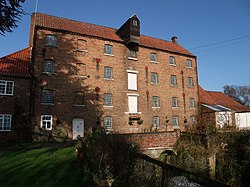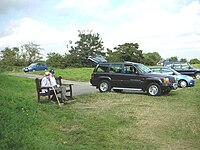Fiskerton, Nottinghamshire
| Fiskerton | |
| Nottinghamshire | |
|---|---|
 Fiskerton Mill, on the River Greet | |
| Location | |
| Grid reference: | SK736511 |
| Location: | 53°3’9"N, 0°54’10"W |
| Data | |
| Population: | 902 (2011) |
| Post town: | Southwell |
| Postcode: | NG25 |
| Local Government | |
| Council: | Newark and Sherwood |
| Parliamentary constituency: |
Newark |
Fiskerton is a village in Nottinghamshire on the west bank of the River Trent about three miles south-east of Southwell. The population of the wider civil parish of 'Fiskerton cum Morton' was 902 at the 2011 census.
The name 'Fiskerton' contains the Old Norse word fiskari (or the Old English equivalent fiscere) meaning 'fisherman', together with tun (Old English), a farmstead, so 'Fishermen's farm/settlement'.[1][2][3]
The waterfront is home to million-pound residential properties,[4] previously residences of merchants and businessmen who commuted in the 19th century to nearby Nottingham by rail from Fiskerton Station.[5]
The village's location beside the Trent attracts walkers, picnickers and casual visitors in summer, centred on the riverside pub/restaurant (was called the Bromley Arms, renamed as The Bromley at Fiskerton in 2014)[6][7] and used as a friendly café-type base also serving snacks and refreshments.
History
The 1086 Domesday entry for Fiskerton mentioned arable land enough for seven ploughs, two mills, a fishery, a ferry and 42 acres of meadow, pasture and woodland.[5]
Fishing and agriculture remained important, but with close proximity to the River Trent, Fiskerton developed other industries. By 1842 there were wharfs, coal yards and warehouses along the river front together with a large malthouse owned by Newark brewer, James Hole. There was a watermill on the River Greet and a windmill on what is now Station Road.[5]
An important development was the opening of the Nottingham to Lincoln railway in August 1846 with the station close to the village centre. By the end of the century, many wharfs and warehouses had disappeared, replaced by substantial residences like Fiskerton House and Fiskerton Manor on the riverside.[5]
The large malthouse on The Wharf closed in 1904 when James Hole decided to concentrate business in Newark, the premises being converted into a grain-store, with the wharf used for loading and unloading materials destined for Southwell corn mill. In the 1970s it became a boat building business and then in the 1980s a private residence.[5]
Until the 1950s there was a ferry boat service over to the other side of the River Trent at Stoke Field.
Fiskerton Mill stands on the River Greet a few hundred yards upstream from its junction with the River Trent.[8]
There was once a wooden postmill here with a substantial brick roundhouse, standing off Station Road. A mill was marked at this site on Chapman's map of 1774. Fiskerton Windmill ceased working at some time in the last quarter of the 19th century and only the roundhouse now remains.[9]
Richard Thomas Parker, who murdered his mother in Fiskerton in 1864, was the last person to be publicly hanged in Nottingham.
Residential development occurred within Fiskerton between 1960 and 2000s, including the Green Drive area in 2002, which gave the village a permanent open space known as the Village Green, culminating in Fiskerton being the commuter village of today.[5]
Fiskerton Cell
The village may have been home to a small monastic cell of Augustinian canons, dependent on the nearby Thurgarton Priory. It may have been founded around 1139, and Ralph D'Aincourt (son of Walter D'Aincourt) is listed as a possible founder.[10]
Doubt has been cast, however, on whether it was truly a monastic cell or a just a chapel/church. Ralph D'Aincourt founded the nearby Thurgarton Priory circa 1119–39, and gave the village of Fiskerton to that priory as part of its endowment.[11] It is thought, therefore, that Fiskerton was not a cell but just a village chapel, with the canons of Thurgarton Priory serving as priests.[12] The cell/chapel was believed to be dedicated to St Mary. There are no remains and its location has been lost.[13]
References
- ↑ Gover, J. E. B.; Mawer, A. & Stenton, F.M.: 'Place-Names of Nottinghamshire , Part' (English Place-Names Society, 1940), page 164
- ↑ Mills, Anthony David: 'A Dictionary of British Place-Names' (Oxford University Press, 2003) ISBN 978-0-19-852758-9
- ↑ Ekwall, Eilert, The Concise Oxford Dictionary of English Place-Names. Oxford, Oxford University Press, 4th edition, 1960. p. 180 ISBN 0198691033
- ↑ Fiskerton House was Manor Excess of £995,000 Savills property Retrieved 19 August 2014
- ↑ 5.0 5.1 5.2 5.3 5.4 5.5 Growth of Fiskerton, Fiskerton cum Morton Retrieved 17 August 2014
- ↑ Whatpub guide Retrieved 17 August 2014
- ↑ Newark Camra Pub Guide: Bromley Arms, Fiskerton Retrieved 17 August 2014
- ↑ http://www.igreens.org.uk/fiskerton_mill.htm Fiskerton mill on the river Greet (pictures)
- ↑ Shaw, T. (1995). Windmills of Nottinghamshire. Page 21. Nottingham: Nottinghamshire County Council. ISBN 0-900986-12-3
- ↑ Cobbett, William (1827). A History of the Protestant "Reformation," in England and Ireland. https://books.google.com/books?id=tEJBAAAAcAAJ&pg=PT123&lpg=PT123&dq=Fiskarton+Cell&source=bl&ots=5A4uz_O56E&sig=9580Lev9GPPnptkFSaKwKDzgkq4&hl=en&sa=X&ei=PBgbUqLGDYWR0AWe-YDYBQ&ved=0CDwQ6AEwAw#v=onepage&q=Fiskarton%20Cell&f=false.
- ↑ A History of the County of Nottingham - Volume 2 : pp120-125 (Victoria County History)
- ↑ National Monuments Record: No. 322463 – @
- ↑ National Monuments Record: No. 322426 – St Marys Chapel



